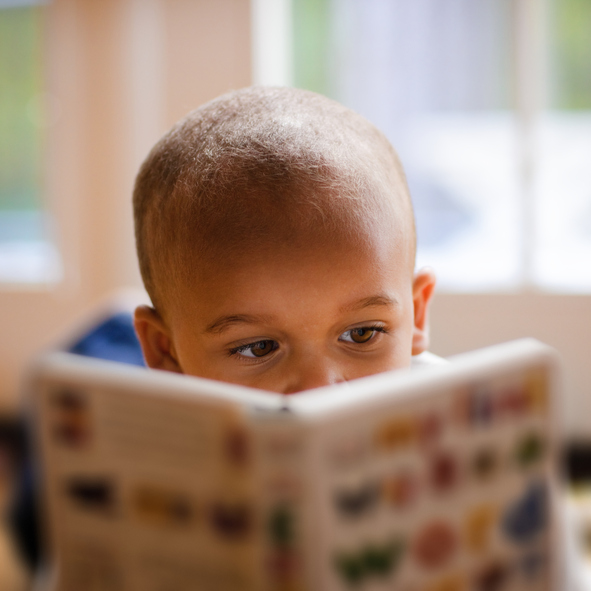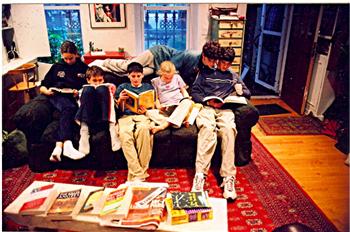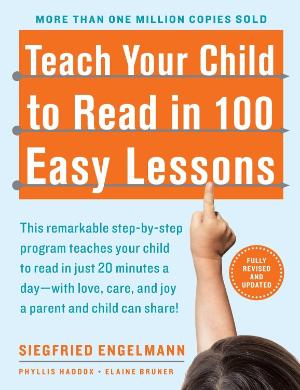
That's not just because you're helping your child develop reading comprehension. You're also nurturing a deep love of reading. And when children love to read, they choose to read independently, become better readers, score higher on achievement tests in all subject areas, and have greater content knowledge than those who don't. School performance correlates more directly with children's reading scores than any other single indicator.
Does your child read every day, not because it’s assigned, but just for fun? Most parents buy board books for their babies and say they hope they'll love reading. And yet, by middle school, most kids stop reading books that aren't assigned in school. In the USA, by the end of middle school, two-thirds of all students do not attain proficiency in literacy and comprehension skills.
What happens? The habit of reading never really gets ingrained in childhood. Our kids love leafing through books as toddlers, looking at the pictures. They may even enjoy reading as early elementary schoolers. But reading is hard work, and life offers so many other ways to entertain themselves that early reading often seems more like work than play. They never get to that delicious place where reading a good book is more fun than almost anything.
But you can inspire a lasting love of reading in your child. Here's how.
1. Read to your child from the earliest age.
And not just at bedtime. Buy board books and cloth books as some of your child's first toys. Carry them around with snacks in the diaper bag. Create "cozy time," a ritual of connection in which you both associate love and cuddling with reading. Any time either of you needs a break, grab a book and read to your child. Post tantrum, during lunch, after school, while you have your coffee, any time can be cozy time.
2. Remove all pressure.
Some experts make a compelling case that when kids struggle to learn to read, it's not because their brain isn't catching on. It's because they feel pressure to understand those squiggles on the page, and they panic. We all know that when the brain is in a state of emergency, it can't learn. So the most important way to support reading (after helping kids love stories) is to remove the pressure. For more on this theory, see "Is Dyslexia a School-Produced Disorder?" by Dr. Peter Gray.
So please don't teach your child to learn to read. Teaching your child to read will take all the fun out of reading and will introduce pressure that will backfire.
Some perfectly intelligent children don't learn to read until they're over seven years old. Don't worry. They'll quickly catch up with those who started at four or five. I know two children who were reading at 3 years old and at 6 years old, respectively. They are both now 9, and in the fourth grade. They both read at about an eighth grade reading level. The only difference is that the early reader feels insecure about no longer being “special,” and often acts obnoxiously superior to other kids.
Should you stop her from teaching herself to read? Of course not. Just don't push it and certainly don't make it your child's claim to fame, because sooner or later everyone else will catch up. It's a bit like whether a child learns to walk at nine months or 16 months. Who cares?
3. Use Phonics instruction as an adjunct.
Many children who grow up immersed in books learn to love them so they're motivated to master the hard skill of reading. They also often learn to recognize whole words on the page.
But this doesn't work for all children. Many children need to learn to sound out words letter by letter, which is also known as the Phonics approach. This is particularly true for English speakers since spelling and pronunciation in English are famously illogical. Repeated studies have demonstrated that Phonics instruction is effective for most children. The key with Phonics instruction is not to let it compromise the child's love of reading. So by all means use phonics as an adjunct, but keep reading to your child and try all the other tips on this page. (Here's a good book on Phonics instruction: Teach Your Child to Read in 100 Easy Lessons.)
If you notice that your child seems to have a hard time recognizing letters, or confuses letters, or can't sound out words, or can't recognize words that she has seen many times before, it is possible that she needs extra support. Discuss your concern with your child's school and ask to speak to their learning specialist, who should be experienced in diagnosis and early intervention.
4. Read to your child as often as possible.
I found that before my children could really participate in meals, reading to them during lunch or an early dinner (when the other parent isn't yet home from work) entertained them enough to keep them sitting. They were much more likely to try the foods I put in front of them with my company and the diversion of a book, than if I let them sit in the high chair or at the kitchen table to eat while I cooked. This is very different from putting kids in front of a screen while they eat. Then, they stare at the screen as they unconsciously put things in their mouth. Being read to is more like listening to the radio; they can look at their food and savor it as they listen, glancing back and forth at the pictures you hold up.
5. Begin visiting the library regularly
...by the time your child is two and she may well prefer reading to any other activity. Use the time in the library to read to your child as well as to select books. My kids would never sit still at library "story times," but if your child likes them, by all means go. To keep track of returning the books on time, take photos (or write down the names) of the books you check out, if your library can't give you a printout. Keep library books on a separate shelf in the living room or kitchen so you don't lose them, and so you can always easily find something new to read. (If you don't take them out of the house, you won't lose them.)
Supervising a toddler and perusing bookshelves is always a challenge; it helps if you can develop a list of authors and books so you can find good ones easily. Librarians usually have a list of favorite books for various ages, and other parents and kids are always a good source of suggestions. Find some series you like and share your child's excitement when you find another book by a beloved author. (See Recommended Children's Books).
6. Don't stop reading to them once they learn to read.
This is a critical tip. Read to him every step of the way, for as long as they'll let you. Continuing to read to your child will keep him interested in reading to himself and developing his skills. And it gives you lots of fodder for great conversations about values and choices.
Parents often complain that their early readers CAN read, but just don't seem interested in doing so. Most kids go through this stage, but you can help to keep it a brief one. The child's problem, of course, is that he can read simple books, but his imagination craves more developed plots and characters. Those books are agonizing work, with too many words he doesn’t know. The labor distracts him from the story. The solution? He needs his parents to keep reading to him, to keep him fascinated with the secrets of books. That's what will motivate him to do the hard work to become a proficient reader.
At this vulnerable stage, it is well worth the extra time to track down books he can read and will find exciting. Picture books with lots of words work well, since he can use the pictures to help him stay interested and figure out the words. Soon, through his work in school, as well as the books he picks up at home, his reading skills will catch up with his appetite for books. Within a few months, he'll be able to handle simple chapter books. At that point, look for series books, which often lure kids on to the next book and the next.

Set up a “cozy reading time” every day. This can be a perfect chill-out time after school, or after lunch in the summer, or a wind-down time at the end of the evening. It’s amazing how motivated kids are to read if this allows them to stay up a little later. We negotiated a half hour later bedtime that our first graders were ready for anyway, as long as it was spent in bed reading a book.
Some six year olds are just so tired by the end of the day, however, that reading is simply too much work for them then. Until your child is ready for bedtime reading, try setting up his cozy reading time while you make dinner, after homework is done. The only downside to this is that you’ll need to scrape out 15 minutes to start him off at what is probably your busiest time of the day.
8. Help her tackle the next level.
Pick a book she can read, but that is a bit harder than she might choose on her own -- a simple chapter book, rather than a picture book, for example. Read together until you have to answer the phone or start dinner, but a minimum of a quarter of the book, so your child is hooked. Then tell her it's time for her read-alone time. It’s her choice. Does she want to keep reading the book you've just gotten her into, or read something else? Most kids grab the book and finish it themselves. (If she doesn't, you may need to drop back a level to a slightly simpler book.) Keep choosing engrossing, slightly harder books.

... during your read-aloud time. But if he stumbles, supply the word. Don't make him stop and sound things out; your goal is to keep him excited about the book by moving forward with the story. I recommend this only for limited periods of time – it tires kids out – and I recommend that you not be rigid about enforcing your child's participation (in other words, have them do every third page, or fourth). If you take the fun out of reading with him, you've done more harm than good.
10. Try smart comics for reluctant readers.
Some kids get a terrific jump start from comics, which are less intimidating to them than chapter books. Bill Watterson’s Calvin and Hobbes books, for instance, are kid pleasers with sophisticated vocabulary and concepts.
11. Never stop reading to her.
I know she can read anything herself now. But why give up such an important time to connect with each other emotionally? Why give up the chance to read books that trigger good discussions about values and choices and hardships and hope? Don’t stop till she fires you. My fourteen year old could read physics books I couldn't fathom, but he still let me read history or politics to him occasionally. The best part for both of us was then talking about what we were reading.
12. Read yourself.
Role model. If they don't see you read, why should they? Discuss what you're all reading at the dinner table. Institutionalize family reading time, when a parent reads to the whole family. As kids get older, they can take over the role of reader, or the book can be passed around the circle.
13. Limit screens.
There is no way a book can compete with a screen. Most kids, given the choice, just won't choose the book often enough to make it a habit. Before you know it, they'll have developed other habits for relaxing, and reading will be something other people do. Research shows that the more TV kids watch before the age of eight, the less they read after the age of eight. Of course, that's a correlation, so it doesn't prove that one leads to the other, but most researchers are convinced. If you want your children to be readers, don't let them get addicted to screens before they have become dedicated readers. Limiting or even banning screen usage until reading is well-established may be the most important thing you can do to encourage reading.
Click here for more on why screens compromise reading and academics.
Citations:
Cullinan, Bernice E. 2000. Independent Reading and School Achievement. School Library Media Research: Research Journal of the American Association of School Librarians. Volume 3.
Cunningham, A. E., and K. E. Stanovich. 1991. Tracking the unique effects of print exposure in children: Associations with vocabulary, general knowledge, and spelling. Journal of Educational Psychology 83(2): 264–274.
Krashen, S. D. 1993. The power of reading: Insights from the research. Englewood, Colo.: Libraries Unlimited.
Reardon, S., Valentino, R. and Shores, K. 2012.“Patterns of Literacy among U.S. Students” in “Literacy Challenges for the Twenty-First Century,” The Future of Children, Volume 22, Number 2, Fall 2012.
Stanovich, K. E., and A. E. Cunningham. 1993. Where does knowledge come from? Specific associations between print exposure and information acquisition. Journal of Educational Psychology 85(2): 211–29.






